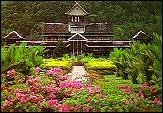
It is the Minangkabaus who hold the key to the history of Negeri Sembilan. The Minangkabaus were immigrants from West Sumatra who settled in Negeri Sembilan between the 15th and 16th century, at the height of the Malaccan Sultanate.
They continued the practice of their rich cultural heritage, which continues on today in the form of the fascinating Adat Perpatih, a matrilineal system of rule and inheritance, unique only to Negeri Sembilan. The Minangkabaus and their adats, or traditions, and are indeed to be credited with Negeri Sembilan's many interesting aspects. This is clearly seen and felt even today, especially in the customs of marriage, ownership of property and dance forms.
The Negeri Sembilan that the early Minangkabaus knew was a rather loose confederation of nine fiefdoms in a secluded valley of the region. It was only in 1773, and with Raja Melewar as the Yam Tuan or ruler, that the 9 separate fiefdoms of Sungai Ujong, Rembau, Johol, Jelebu, Naning, Segamat, Ulu Pahang, Jelai and Kelang were unified.
Negeri Sembilan's modern history then began with British intervention in the districts of Sungai Ujong, Rembau and Jelebu. In Sungai Ujong, the British took the opportunity to intervene in the region's politics by taking part in and then ending, the conflict between Dato' Kelana and Dato' Bandar, which was affecting the trade of tin along the Linggi River. The British's support of Dato' Kelana was rewarded by the appointment of W.A. Pickering as British resident in 1874.
Come 1889, a treaty was signed between the Yam Tuan Seri Menanti and the four Datuk Undangs, installing the Yam Tuan as ruler of Negeri Sembilan, who was to be "aided" by Martin Lister as the first British Resident of Negeri Sembilan.
| |







